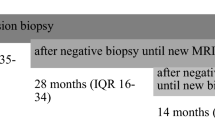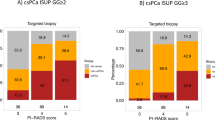Abstract
Background
Several consensus statements recommend serial serum prostate-specific antigen (PSA), multi parametric magnetic resonance imaging (mpMRI), and prostate biopsy following partial gland ablation. We determined the rate of persistent in-field disease following primary partial gland cryo-ablation and whether PSA or mpMRI are reliable predictors of in-field disease persistence.
Methods
Between March 2017 and July 2019, subjects meeting eligibility criteria for partial gland cryoablation were enrolled into an IRB approved outcomes registry. PSA, mpMRI, and prostate biopsy (four cores targeting the ablation zone + six ipsilateral systematic cores) were performed per protocol 6 months following intervention. Binary logistic regression was employed to calculate odds ratio (OR) of PSA decrease, and suspicious mpMRI effect on cancer persistence. The performance of mpMRI for predicting in-field persistence of PCa was evaluated by area under the receiver operation characteristics curve (AUC).
Results
Of the 83 eligible men undergoing partial gland cryoablation, 70 (84.3%) underwent 6-month protocol prostate biopsy. Five (7.1%) biopsies exhibited any in-field disease persistence. Only one (1.4%) of these cancers was Gleason grade > 1. Neither PSA decrease or suspicious mpMRI reliably predicted cancer persistence, with OR of 1.6 (0.25–8.6) and 1.5 (0.02–1.3), respectively. AUC of mpMRI for predicting in-field disease persistence was 0.554.
Conclusions
In this cohort of patients undergoing partial gland cryo-ablation, the incidence of persistent disease was low. PSA and mpMRI were not reliable predictors of in-field disease persistence. Based on these data, consideration may be given to deferring early follow-up biopsy in appropriate patients.
This is a preview of subscription content, access via your institution
Access options
Subscribe to this journal
Receive 4 print issues and online access
$259.00 per year
only $64.75 per issue
Buy this article
- Purchase on Springer Link
- Instant access to full article PDF
Prices may be subject to local taxes which are calculated during checkout

Similar content being viewed by others
References
Karavitakis M, Ahmed HU, Abel PD, Hazell S, Winkler MH. Tumor focality in prostate cancer: implications for focal therapy. Nat Rev Clin Oncol. 2011;8:48–55.
Ong WL, Evans SM, Evans M, Tacey M, Dodds L, Kearns P, et al. Trends in conservative management for low-risk prostate cancer in a population-based cohort of Australian men diagnosed between 2009 and 2016. Eur Urol Oncol. 2019:S2588-9311(19)30055-0. https://doi.org/10.1016/j.euo.2019.04.006.
Loeb S, Byrne N, Wang B, Makarov D, Becker D, Wise D, et al. Exploring variation in the use of conservative management for low-risk prostate cancer in the veterans affairs healthcare system. Eur Urol. 2020;77:683–6. https://doi.org/10.1016/j.eururo.2020.02.004.
Marra G, Ploussard G, Ost P, De Visschere PJL, Briganti A, Gandaglia G, et al. Focal therapy in localised prostate cancer: Real-world urological perspective explored in a cross-sectional European survey. Urol Oncol. 2018;36:529 e11–e22.
van der Poel HG, van den Bergh RCN, Briers E, Cornford P, Govorov A, Henry AM, et al. Focal therapy in primary localised prostate cancer: the European association of urology position in 2018. Eur Urol. 2018;74:84–91.
Lepor H, Gold S, Wysock J. Focal ablation of prostate cancer. Rev Urol. 2018;20:145.
Valerio M, Cerantola Y, Eggener SE, Lepor H, Polascik TJ, Villers A, et al. New and established technology in focal ablation of the prostate: a systematic review. Eur Urol. 2017;71:17–34.
Scheltema MJ, Tay KJ, Postema AW, de Bruin DM, Feller J, Futterer JJ, et al. Utilization of multiparametric prostate magnetic resonance imaging in clinical practice and focal therapy: report from a Delphi consensus project. World J Urol. 2017;35:695–701.
Tay KJ, Amin MB, Ghai S, Jimenez RE, Kench JG, Klotz L, et al. Surveillance after prostate focal therapy. World J Urol. 2019;37:397–407.
Van Den Bos W, Muller BG, Ahmed H, Bangma CH, Barret E, Crouzet S, et al. Focal therapy in prostate cancer: international multidisciplinary consensus on trial design. Eur Urol. 2014;65:1078–83.
Kenigsberg AP, Llukani E, Deng FM, Melamed J, Zhou M, Lepor H. The use of magnetic resonance imaging to predict oncological control among candidates for focal ablation of prostate cancer. Urology. 2018;112:121–5.
Rosenkrantz AB, Scionti SM, Mendrinos S, Taneja SS. Role of MRI in minimally invasive focal ablative therapy for prostate cancer. AJR Am J Roentgenol. 2011;197:W90–6.
Kongnyuy M, Halpern DM, Liu CC, Kosinski KE, Habibian DJ, Corcoran AT, et al. 3-T multiparametric MRI characteristics of prostate cancer patients suspicious for biochemical recurrence after primary focal cryosurgery (hemiablation). Int Urol Nephrol. 2017;49:1947–54.
Dickinson L, Ahmed HU, Hindley RG, McCartan N, Freeman A, Allen C, et al., editors. Prostate-specific antigen vs. magnetic resonance imaging parameters for assessing oncological outcomes after high intensity–focused ultrasound focal therapy for localized prostate cancer. Urol Oncol. 2017;35:30.e9–15. https://doi.org/10.1016/j.urolonc.2016.07.015.
Chao B, Llukani E, Lepor H. Two-year outcomes following focal laser ablation of localized prostate cancer. Eur Urol Oncol. 2018;1:129–33.
Felker ER, Raman SS, Lu DS, Tuttle M, Margolis DJ, ElKhoury FF, et al. Utility of multiparametric MRI for predicting residual clinically significant prostate cancer after focal laser ablation. Am J Roentgenol. 2019;213:1253–8.
Bryk DJ, Llukani E, Taneja SS, Rosenkrantz AB, Huang WC, Lepor H. The role of ipsilateral and contralateral transrectal ultrasound-guided systematic prostate biopsy in men with unilateral magnetic resonance imaging lesion undergoing magnetic resonance imaging-ultrasound fusion-targeted prostate biopsy. Urology. 2017;102:178–82.
Lepor H, Llukani E, Sperling D, Futterer JJ. Complications, recovery, and early functional outcomes and oncologic control following in-bore focal laser ablation of prostate cancer. Eur Urol. 2015;68:924–6.
Ahmed HU, Dickinson L, Charman S, Weir S, McCartan N, Hindley RG, et al. Focal ablation targeted to the index lesion in multifocal localised prostate cancer: a prospective development study. Eur Urol. 2015;68:927–36.
Author information
Authors and Affiliations
Corresponding author
Ethics declarations
Conflict of interest
The authors declare that they have no conflict of interest.
Additional information
Publisher’s note Springer Nature remains neutral with regard to jurisdictional claims in published maps and institutional affiliations.
Rights and permissions
About this article
Cite this article
Wysock, J.S., Becher, E., Gogaj, R. et al. Early oncological control following partial gland cryo-ablation: a prospective experience specifying reflex MRI guided biopsy of the ablation zone. Prostate Cancer Prostatic Dis 24, 114–119 (2021). https://doi.org/10.1038/s41391-020-0244-0
Received:
Revised:
Accepted:
Published:
Issue Date:
DOI: https://doi.org/10.1038/s41391-020-0244-0
This article is cited by
-
Partial gland cryoablation for prostate cancer — where are we?
Nature Reviews Urology (2023)
-
Focal therapy in intermediate- and high-risk prostate cancer
memo - Magazine of European Medical Oncology (2023)
-
Minimally Invasive Procedures in the Diagnosis and Treatment of Localized Prostate Cancer: an Interventional Radiologist’s Perspective
Current Oncology Reports (2022)
-
A Prospective Pilot Study Investigating Performance of 18F-Fluciclovine PET Imaging for Detection of Prostate Cancer 2 Years Following Primary Partial Gland Cryoablation
Nuclear Medicine and Molecular Imaging (2022)
-
MRI guided procedure planning and 3D simulation for partial gland cryoablation of the prostate: a pilot study
3D Printing in Medicine (2020)



